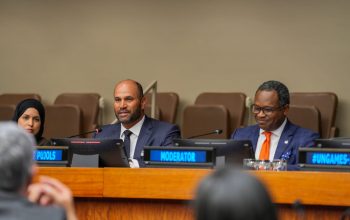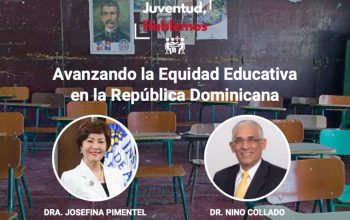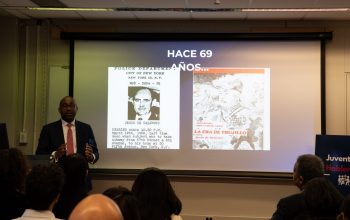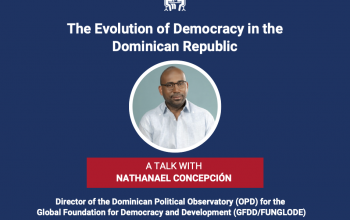news
The potential and limitations of gold mining, a subject for analysis
March 24, 2011
 Experts on mining-related topics of impact, mining best practices and public policies, as well as the chief executive of Pueblo Viejo Dominicana Corporation, participated in the panel "Global perspectives on gold mining: assessing the potential and limitations," on Wednesday, March 23, an event organized by FUNGLODE and its sister
Experts on mining-related topics of impact, mining best practices and public policies, as well as the chief executive of Pueblo Viejo Dominicana Corporation, participated in the panel "Global perspectives on gold mining: assessing the potential and limitations," on Wednesday, March 23, an event organized by FUNGLODE and its sister
organization in the United States, the GFDD.
Omar Ramirez, Director of FUNGLODE’s Center for Environmental and Sustainable Development Studies, Executive Vice-President of the President’s Commission on Climate Change and Clean Development Mechanism of the Government of the Dominican Republic, and former Minister of the Environment of the Dominican Republic, was the moderator of the event. In his opening remarks, he stated that mining is “a
worldwide subject for debate and the Dominican Republic is no exception because one of the key elements for its development is mining, an activity that remains in place since the arrival of the Spaniards."
Before giving way to the first panel of the night, he said that "from prehistory through 2009, 161.000 tons of gold have been extracted, which is the equivalent to two full Olympic swimming pools. Most of the extraction has occurred in the last 50
years."
After raising the issue, David Le Blanc, Senior Sustainable Development Officer of the United Nations (UN) Department for Economic and Social Affairs, described the impact of mining, which, he said, depends on the size of the mine and its operations. "Undoubtedly, impacts exist in the areas of the environment, land use, waste pollution, social issues…," said Le Blanc, notwithstanding recognizing that with the passage of time and the
development of technology the impacts have lessened, while the social and the exploitation conditions of the communities surrounding the mines have improved.
"In the case of environmental impacts, they arise from the use of the soil, water and energy consumption, and waste pollution," stated the representative of the multilateral agency. "But, the level is also conditioned by the extraction technology, waste treatment, climatic and topographic
factors ….," he added.
In the area of water and energy, Le Blanc expressed that "we speak of large consumption per kilogram of gold. The lesson is to plan very carefully the use of water, including drinking water. The efficiency of its use has improved over the years by dropping significantly, according to studies."
As for pollution, mainly related to drainage of toxic substances, the guest speaker also mentioned the
existence of technologies that help reduce it. In regard to social impacts, he related them to the conflicts that arise within the communities "with respect to water use and natural resources. Also in reference to the labor used which is increasingly more local and less imported, or to the vulnerability of women as this is largely a male activity. These conflicts have sometimes led to the militarization of the mining zones."
Octavio Lopez, Director of
Mining, was the second panelist to speak. His presentation addressed the idea of bringing mining down the road of sustainable development. "The Dominican Republic’s mining potential is enormous, both metallic and non metallic mining: gold and silver, bauxite, zinc, clay, gypsum, limestone, marble, coral limestone, Larimar and amber, among others."
He stressed the support that the sector has received in European Union to "have a more
intense and favorable mining exploration in the country with relevant instruments. There is a digitalized mining cadastre with the idea of making it available online." Also, it addresses public policy on mining issues, guarantees of equality, investment, reduction of bureaucracy, and others. "Adding to that and considering corporate social responsibility, for example, there has been an evolution towards a more responsible mining."
 After discussing how mining is also having an impact on communities and the economic prospects of mining, he stressed that "sustainable development has been set as the model that inspired the management of Dominican mining. We encouraged the Dominican Republic to develop a plan for the comprehensive management of land so that we can determine its use based on its conditions and
After discussing how mining is also having an impact on communities and the economic prospects of mining, he stressed that "sustainable development has been set as the model that inspired the management of Dominican mining. We encouraged the Dominican Republic to develop a plan for the comprehensive management of land so that we can determine its use based on its conditions and
resources." He also pointed out that they are advocating for the sectorial synergies to move the country’s productive mechanisms in a different way, depending on each sector’s potential.
"We recognize that there is a rising tide of opposition to mining and that must lead us to improve our business with a view to having a mining industry socially and environmentally responsible." In the end, among other proposals, he suggested
promoting artisanal mining through the cooperatives as an alternative to help tackle poverty and to design a portfolio of social investment projects to be financed with the profits that the government receives from mining. "There are guaranties that we could facilitate a true social remediation."
Ben Peachey, Director of Communications of the International Council on Mining and Metals (ICMM), said that this country has many mining opportunities and that
Pueblo Viejo generates benefits for both the country and the company.
His presentation was based mainly on showing the work done by ICMM, which is made of mining companies operating in 800 locations in 54 countries worldwide. "Our work is based on sustainable development and we try that our companies focus on it, this is the reason why we make recommendations and evaluate them," added the executive upon his arrival from London.
To join
ICMM, each member company must sign a commitment on sustainable development in carrying out their work. "And to ensure compliance with this commitment, we write annual reports containing actual demonstrations of compliance by the companies. And they are monitored by independent staff. "
Finally, Manuel Bonilla, the newly appointed President of Pueblo Viejo Dominicana Corporation, the gold mining project developed by Barrick and Gold Corporation near
Cotuí, was the last speaker and he showed figures and photos on the current status of the project and the processes associated with environmental remediation, occupational safety, employment and community solidarity, among others.
In the section on environmental remediation he wanted to make clear the legacy of contamination with sulfides and the environmental damage they received from Rosario Dominicana. "We are trying, but it will take some years to
remedy what Rosario caused during those 25 years," he said in explaining the plans for sulfur cleanup, reforestation, land recovery, and the protection and care of biodiversity with the idea of leaving the impact area and its surroundings in optimal environmental conditions in the future.
 In terms of their operations to date, he said that they had limited
In terms of their operations to date, he said that they had limited
themselves to construction work and the installation of equipment for the extraction and exploitation of minerals in the area. "We are the fifth project in the world to install state-of-the-art technology for the direct treatment of the sulfides in order to use them and to avoid contamination through the “uniclaves," which are large cylinders 33 meters long and six meters in diameter, where materials are processed to separate the sulfides from the minerals and
the inert substances that are used to fill the affected areas before rebuilding them with organic material and plants.
Throughout his presentation, Bonilla confirmed that the company will bear the cost of the inherited environmental cleanup and which was the State’s responsibility. "In the beginning we wanted to pay only half, but in the end we have told the government that we would cover the $75 million that the State would have had to pay to comply
with that part of the contract." He ended his presentation with data on the benefits that the State would obtain as a result of the signed contract, and with a description of social projects, community work, and government employment, among others.






